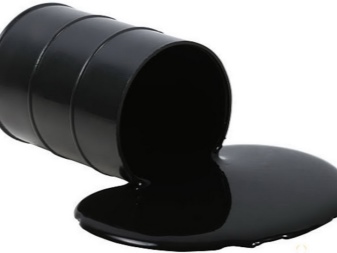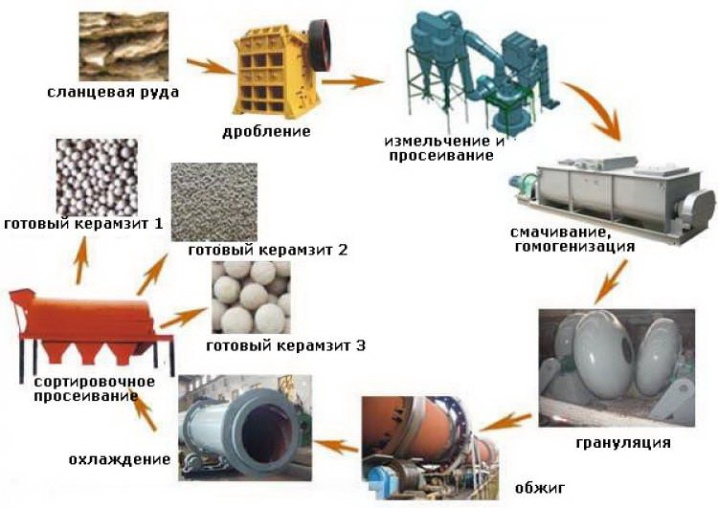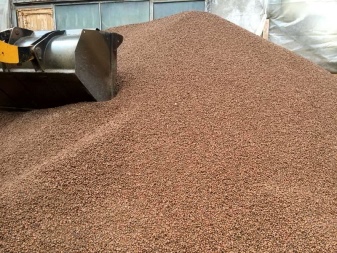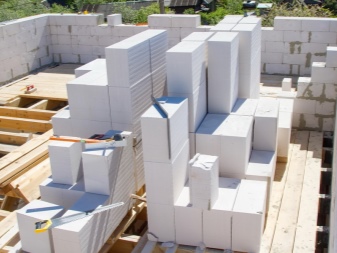Everything you need to know about expanded clay

Ceramic granules are familiar to many today because they have a wide range of applications. Moreover, this material has its own characteristics and secrets. Taking into account the unique performance properties of expanded clay, the number of users who want to learn as much as possible about these granules is constantly increasing.

What it is?
At its core, expanded clay is porous inside grains (granules), resembling balls of different sizes. The raw materials for the manufacture of material in this case are shale, which are divided into varieties. They are heat treated in special ovens. As a result of a similar process, the mentioned grains with the so-called sintered outer shell are obtained. The latter is characterized by increased density. The key characteristics and performance indicators of the material are due precisely its porous structure and presence in the air channels.




The variable form of granules directly depends on the manufacturing technology... Today you can find elements in the form of almost regular balls, as well as resembling cubes. In addition, the material is produced in various sizes and specific gravity.

It is important to take into account that the properties of expanded clay do not depend on geometry.
What and how is expanded clay made of?
One of the important production stages is selection of raw materials, from which expanded clay of certain fractions and forms will be made in the future. At this stage, the clay is sorted and the maximum removal of impurities is carried out. If necessary, substances that provide and stimulate swelling are added to the composition in parallel. These include:
- peat;
- coal;
- diesel oil;
- fuel oil and others.




The next step is the formation of raw granules, which, by the way, can be from different types of clay. Then the granules are dried and sent to a drum-type kiln for firing at a temperature of about 1300 degrees. In order to activate the swelling, the balls must be constantly stirred during the heat treatment. One batch is fired for about half an hour.

The main properties of expanded clay are determined by the quality of raw granules (grains), which are produced in one of several ways.
- Wet... It provides for the mixing of clayey rock with water and special impurities, on which the characteristics of the material will depend. The finished mixture is fed into a drum, continuously rotating oven.
- Dry... It is used for the production of expanded clay from a homogeneous rocky rock with a minimum concentration of impurities. It is simply crushed and sent to the oven. This option for the manufacture of granules, taking into account a number of factors, is considered the simplest and most economical.
- Plastic... This method involves significant financial costs. At the same time, it ensures the maximum performance of the material. The technology provides for the moistening of raw materials and the introduction of additives to obtain a homogeneous initial mass. One of the clear advantages of using the plastic method and a belt press is the formation of elements that are almost the same in size and shape.




The result of using each of the listed methods directly depends on the type of clay used.By the way, it is quite possible to make expanded clay on your own if you have the appropriate equipment. These are modern mini-plants.
Main characteristics and properties
The record popularity and wide scope of the described material are due to its performance characteristics. Naturally, the main parameters are regulated by the current provisions of GOST. In different volumes, expanded clay is successfully used not only by builders. Some important metrics are key pluses.
- Minimum weight. Many are interested in how many kilograms a cube or bag of expanded clay weighs. Taking into account the raw materials used in the production, as well as the characteristics of impurities, 1 m3 can be 250-1000 kg.
- Low thermal conductivity. Due to the content of air in the pores of the granules, they poorly transmit heat, therefore, retain it as efficiently as possible. As a result, this relatively not very voluminous material is a good insulation.
- Long service life. It is no secret that ceramics can serve for decades without losing their main characteristics over time.
- Inertia... In particular, acids and alkalis are not capable of breaking down fired clay balls, like many other chemicals.
- Fire safetydue to the fact that expanded clay can withstand elevated temperatures. It is important to take into account that no harmful substances are emitted and no ignition occurs.
- Soundproofing properties.
- Low temperature resistance subject to the integrity of the shell and the absence of moisture inside the granules.
- Environmental friendlinessprovided by the use of exclusively natural raw materials. As a result, products that are absolutely safe for humans and other living organisms go on sale.





The main disadvantage of expanded clay is its low hygroscopicity. When wet, the material intensively absorbs moisture and then dries out for a very long time. This fact must be taken into account when using it, especially in construction.
Based on this feature, it is strongly recommended to equip hydro and vapor barrier layers.

Species overview
The material in question can be called with confidence a true veteran of the construction industry. Despite this, it is now widely used, and not only as a heat insulator or filler for concrete and other mixtures. Today expanded clay is also used as a decorative material., which looks aesthetically pleasing when implementing various design solutions. In this case, the key parameter for the classification is the size of the granules, taking into account which three main varieties can be distinguished.


Sand
In this case, the grain sizes vary. within 5 mm. Such fine expanded clay is the result of crushing larger elements. An alternative production method is the firing of raw material residues. The result is a fraction that is successfully used as a component of ultra-lightweight concrete and cement mortars.


Gravel
This category includes grains that have an exceptionally round shape with a size of 5-40 mm. The production process is reduced to the swelling of raw materials under the influence of elevated temperatures in special installations. The main characteristic of expanded clay gravel is its high insulating performance.


It is used most often for insulation, and also as a component in the production of concrete mixtures.
Crushed stone
This refers to another type of large-sized expanded clay with granule sizes of 5-40 mm. It is important to take into account that in this case, the grain sizes can differ significantly from each other.... And also crushed stone can be produced in any shape (angular elements are most often found). In the process of their manufacture, the ceramic mass is crushed.


The material is used as a filler for lightweight concrete mixes.
Fractions
Modern producers of expanded clay offer their regular and potential customers a fairly wide range of products. Taking into account the fraction of the material, several types of it can be distinguished.
- 0 to 5 mm - sand, screening, fine expanded clay crumb. As a rule, we are talking about industrial waste. They are used mainly as ordinary sand for the preparation of solutions and dumps. The main advantage of the material in this case is its minimal cost compared to ordinary sand used in construction.
- 5 to 10 mm - the most widespread and demanded faction, which is now widely used in various fields. This is primarily due to the maximum bulk density. The material is often used as an additive to larger fractions to fill voids in solutions. However, this is not only about construction. Such expanded clay is often used in summer cottages and in other places when implementing design ideas.
- 10 to 20 mm - no less popular fraction of expanded clay, which, for example, often becomes the main component in the arrangement of drainage for plants. No less effective material for roofing work - insulation of roofs and attics, as well as for roof sloping. Provides reliable protection against mildew and mildew if used when pouring a floor.
- From 20 to 40 mm. This largest fraction most often plays the role of a component of lightweight concrete in its production in large volumes. And it can also become a heater in situations where a thick layer is needed.

Marking
In this case, the material is classified based on its bulk density, which is measured in kilograms per cubic meter. This indicator is also called volumetric weight, that is, the ratio of volume to mass. Now on the market there is expanded clay grades from M250 to M1000.
By continuously rotating the kiln, most of the pellets are rounded. You can determine the grade of the material by knowing the size of the grains. And we are talking about the following options:
- fraction from 5 to 100 mm - grade 400-450 kg / m3;
- fraction from 10 to 20 mm - grade 350-400 kg / m3;
- Fraction from 20 to 40 mm - grade 250-350 kg / m3

The current GOST standards regulate the performance indicators of expanded clay grades from M250 to M600. At the same time, the current technical conditions allow the production of grades M800 and M1000.

To navigate such a classification, it is worth remembering that the lower the brand, the higher the quality.
Manufacturers
To date, the release of the described material has been established by large enterprises and small firms. In the corresponding segment of the modern market, the leading positions are occupied by the products of several companies.
- Aleksinsky expanded clay plant - one of the largest producers of expanded clay. There are six brands of material on sale - from M250 to M450.


- "Experiment" Is a relatively young company that in a record short time was able to earn a reputation for high quality products. The plant produces expanded clay of several categories. In this case, we are talking about expanded clay sand, as well as all types of gravel. Delivery is possible in big bags, containers, cans up to 5 "cubes" and in bulk.


- Plant "Keramzit" (Serpukhov). The company cooperates with many large enterprises, the list of which includes, in particular, Rosneft and Gazprom. The products of this manufacturer are presented in several price categories. The most expensive option is high quality expanded clay sand. It should be borne in mind that the delivery of material from the plant is carried out exclusively in bulk.


- "KlinStroyDetal" - an enterprise that produces high-quality products, which will be the best choice if expanded clay material of fractions 5-10 and 10-20 mm is required.


- Ryazan expanded clay production plant - today one of the few companies that have established the production of 10-20 mm fraction (M250) in industrial volumes. At the same time, the key competitive advantages are the affordable cost of products and various forms of delivery.


Areas of use
Taking into account the performance indicators, different brands of the material in question are widely used in different industries. This is not only about modern construction. For example, paths on personal plots and in park areas are made out with decorative expanded clay. Let's list the most common ways to use expanded clay.
- Filler for concrete mixes (light and ultralight) used in the process of pouring monolithic structures and rough screed. The presence of such a component allows you to minimize the weight of the future structure without compromising strength and other performance characteristics.
- Effective insulation, the properties of which are due to the porous structure of the granules. They fill cavities in floors, ceilings and walls.
- Backfilling during the installation of foundation structures, due to which the risk of freezing of concrete is minimized, and the deepening is also reduced.
- The main component of expanded clay concrete blocks, widely used in low-rise construction. This material is characterized by high thermal insulation performance and low weight.
- Arrangement of a dry screed for fast and efficient leveling of the plane of the future floor covering. In this case, the basis of the mixture is precisely expanded clay grains, due to which the load on the floors is minimized.
- Backfilling of drainage channels. In this case, when choosing a fraction and grade, preference is given to grains with a minimum porosity. The key point in such situations is hygroscopicity.
- Arrangement of heating mains. Expanded clay is poured over the pipeline to create a high-quality insulating layer that prevents heat loss. The use of grains as an insulator greatly simplifies the repair work.






Expanded clay is also used in the agricultural sector. Its grains are used in the arrangement of drainage systems, which remove excess moisture from the roots, preventing rotting and the formation of fungus. At the same time, the process of air exchange is stimulated, which is most important for plants planted in clay soil.
At home, expanded clay is successfully used for growing potted flowers. We are talking, for example, about orchids.


In addition to all of the above, one of the rather promising ways to use expanded ceramic material is hydroponics. It becomes an effective soil substitute for various plants.

At the same time, the nutrient substrate is absorbed by the porous structure, which subsequently gradually enters the root system.
Transportation features
Transportation of any bulk materials is carried out in accordance with certain rules. The seller, carrier and buyer must be familiar with them. Otherwise, controversial situations often arise that have an extremely negative impact on mutually beneficial cooperation between different companies and organizations.
Various expanded clay materials can now be found at almost any construction site. Taking into account all its features, the transportation of granules of a particular fraction and brand is regulated by GOST 32496-2013.


It is important to remember that the norms and recommendations enshrined in the relevant documents are binding.
To prevent the risks of losses during the transportation of the described ceramic grains will allow following a few simple rules. First of all, this refers to the delivery of expanded clay in bulk. The main focus is on the tightness of the cargo compartment of the vehicle. It is allowed to use special thresholds for equipping the sides of the body.A tarpaulin is most often spread on top to prevent the transported material from scattering.

Analogs
For all its advantages, expanded clay is not a panacea. So, blocks for low-rise construction can be easily replaced with the same aerated concrete... When it comes to filler, the alternative can be foam plastic, the small particles of which will be an effective drainage element for flower pots. And also the foam is a high-quality insulation.


Another substitute for expanded clay is agloporite, which is a man-made material with a porous structure and low weight. It is available on the market in the form of sand, gravel and crushed stone, and is widely used as thermal insulation backfill.

If you need to find a replacement for flowers, then the best options would be ordinary pebbles and crushed stone of the corresponding fraction. When arranging heat-insulating layers, instead of the described material, mineral wool is successfully used. Low weight is one of its main performance characteristics.


At the same time, the list of important disadvantages includes a potential health hazard.
In addition to all of the above, attention should also be paid to expanded vermiculite. The main advantage of this insulation is its environmental friendliness. It is produced by accelerated roasting of vermiculite concentrate - hydromica.

It is important to take into account that from a financial point of view, the material is quite profitable, especially against the background of the maximum service life.
Another replacement option is perlite, which is a multifunctional and common building material. Perlite bitumen, asbestos perlite cement, slabs and other products are produced from it.


For information on how to make a lightweight expanded clay screed, see the next video.













The comment was sent successfully.